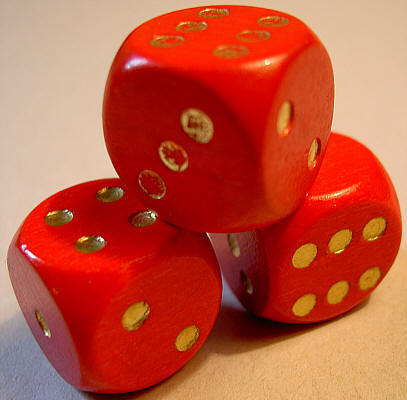Rolling Right Along
 Suppose we roll
3
fair, standard six-sided dice. Any dice that show a
6
are removed, after which the remaining dice, (if any), are rolled again. As before, any dice showing a
6
are removed, and any remaining dice are rolled again. We repeat this process until all
3
dice have been removed.
Suppose we roll
3
fair, standard six-sided dice. Any dice that show a
6
are removed, after which the remaining dice, (if any), are rolled again. As before, any dice showing a
6
are removed, and any remaining dice are rolled again. We repeat this process until all
3
dice have been removed.
The expected number of rolls needed until all 3 dice have been removed is b a , where a and b are positive coprime integers. Find a − b .
Image Credit: Wikimedia Walter J. Pilsak
The answer is 9565.
This section requires Javascript.
You are seeing this because something didn't load right. We suggest you, (a) try
refreshing the page, (b) enabling javascript if it is disabled on your browser and,
finally, (c)
loading the
non-javascript version of this page
. We're sorry about the hassle.
2 solutions
Let E ( n ) be the expected number of rolls of n dice needed before each of the dice has shown a 6 and been removed according to the description in the text of the question.
It is well-known that E ( 1 ) = 6 . Now for two dice, there is a probability of 3 6 1 that both dice show 6 on the first roll, a probability of ( 6 5 ) 2 = 3 6 2 5 that neither do and a probability of 3 6 1 0 that precisely one of the dice shows a 6 . Thus
E ( 2 ) = 3 6 1 ∗ 1 + 3 6 1 0 ∗ ( 1 + E ( 1 ) ) + 3 6 2 5 ∗ ( 1 + E ( 2 ) )
⟹ 3 6 1 1 ∗ E ( 2 ) = 3 6 9 6 ⟹ E ( 2 ) = 1 1 9 6 .
Next, for 3 dice, there is a probability of 2 1 6 1 that all 3 dice show 6 on the first throw, 3 ∗ ( 6 5 ) 2 ∗ 6 1 = 2 1 6 7 5 that precisely one dice does, 3 ∗ ( 6 1 ) 2 ∗ 6 5 = 2 1 6 1 5 that precisely 2 do and ( 6 5 ) 3 = 2 1 6 1 2 5 that none do. We then have that
E ( 3 ) = 2 1 6 1 ∗ 1 + 2 1 6 7 5 ( E ( 2 ) + 1 ) + 2 1 6 1 5 ( E ( 1 ) + 1 ) + 2 1 6 1 2 5 ( E ( 3 ) + 1 )
⟹ 2 1 6 9 1 E ( 3 ) = 2 1 6 3 0 6 + ( 2 1 6 7 5 ) ( 1 1 9 6 ) ⟹ E ( 3 ) = 1 0 0 1 1 0 5 6 6 .
Thus a − b = 1 0 5 6 6 − 1 0 0 1 = 9 5 6 5 .
Solved using the same method. I wasn't much familiar with Expectations, read about it on the net and afterwards found it rather straight forward to reach the solution.
Log in to reply
Yes, once you have the general concept it is pretty straightforward. Glad this question led you to learn more about Expectations. :)
Why are you permuting the dices aren't they identical??
Log in to reply
They are, but for the purpose of creating the sample space we consider them to be distinct. So, for example, with two dice the sample space consists of 6 ∗ 6 = 3 6 outcomes, each having the same probability of occurring. 1 of these outcomes results in two 6 's, 1 0 result in precisely one 6 and 2 5 of which result in no 6 's. Have a look at this link for further explanation.
The process is a Markov chain with transition matrix:
P = ⎣ ⎢ ⎢ ⎢ ⎢ ⎡ 2 1 6 1 2 5 0 0 0 7 2 2 5 3 6 2 5 0 0 7 2 5 1 8 5 6 5 0 2 1 6 1 3 6 1 6 1 1 ⎦ ⎥ ⎥ ⎥ ⎥ ⎤
Finding the fundamental matrix:
N = ⎝ ⎜ ⎛ ⎣ ⎢ ⎡ 1 0 0 0 1 0 0 0 1 ⎦ ⎥ ⎤ − ⎣ ⎢ ⎡ 2 1 6 1 2 5 0 0 7 2 2 5 3 6 2 5 0 7 2 5 1 8 5 6 5 ⎦ ⎥ ⎤ ⎠ ⎟ ⎞ − 1 = ⎣ ⎢ ⎡ 9 1 2 1 6 0 0 1 0 0 1 2 7 0 0 1 1 3 6 0 1 0 0 1 5 4 9 0 1 1 6 0 6 ⎦ ⎥ ⎤
Finally the expected number of steps to reach the absorbing state is:
⎣ ⎢ ⎡ 9 1 2 1 6 0 0 1 0 0 1 2 7 0 0 1 1 3 6 0 1 0 0 1 5 4 9 0 1 1 6 0 6 ⎦ ⎥ ⎤ ⎣ ⎢ ⎡ 1 1 1 ⎦ ⎥ ⎤ = ⎣ ⎢ ⎡ 1 0 0 1 1 0 5 6 6 1 1 9 6 6 ⎦ ⎥ ⎤
and since we started from the first state our expected number of rolls is 1 0 0 1 1 0 5 6 6 .